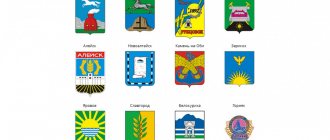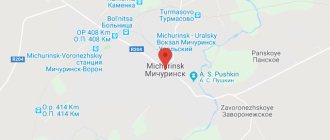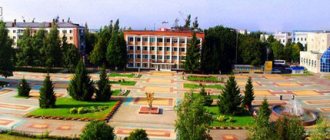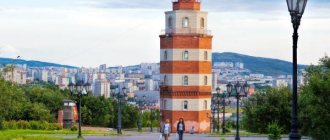Uvarovo
(Tambov Region)
OKATO code:
68430
Founded:
1699
Urban settlement since:
1960
City since:
1966 City of regional subordination
Center:
Uvarovsky district
Telephone code (reference phone)
| 47558***** | 21-9-74 |
Deviation from Moscow time, hours:
0
Geographic latitude:
51°59′
Geographic longitude:
42°16′
Altitude above sea level, meters:
140 Sunrise and sunset times in the city of Uvarovo
Content
- 1 A little about Uvarov
- 2 Districts of Uvarov
- 3 How to get to Uvarov 3.1 by plane
- 3.2 by train
- 3.3 by bus
- 3.4 by car
- 3.5 on the ship
Map
| Uvarovo: maps |
Uvarovo: photo from space (Google Maps) Uvarovo: photo from space (Microsoft Virtual Earth)
| Uvarovo. Nearest cities. Distances in km. on the map (in brackets along roads) + direction. Using the hyperlink in the distance , you can get the route (information courtesy of the AutoTransInfo website) | |||
| 1 | Muchkapsky | 20 (44) | SE |
| 2 | Rzhaksa | 24 (23) | NW |
| 3 | Inzhavino | 39 (49) | WITH |
| 4 | Romanovka (Saratov region) | 42 (199) | SE |
| 5 | Ternovka (Voronezh region) | 56 (111) | SW |
| 6 | Zherdevka | 57 (90) | Z |
| 7 | Satinka | 59 (75) | NW |
| 8 | Gribanovsky (Voronezh region) | 62 (90) | YU |
| 9 | Turks (Saratov region) | 69 (241) | IN |
| 10 | Borisoglebsk | 69 (77) | YU |
| 11 | Znamenka | 74 (98) | NW |
| 12 | Tokarevka | 75 (90) | Z |
| 13 | Balashov | 78 (162) | SE |
| 14 | Will clean | 80 (120) | NE |
| 15 | Rasskazovo | 80 (79) | WITH |
| 16 | Kirsanov | 80 (98) | NE |
| 17 | Sands (Voronezh region) | 82 (123) | YU |
| 18 | Kotovsk | 84 (113) | NW |
| 19 | Arkadak | 84 (214) | IN |
| 20 | Povorino | 87 (105) | YU |
| 21 | Novaya Lyada | 90 (95) | NW |
| 22 | Tamala (Penza region) | 91 (139) | NE |
| 23 | Builder | 93 () | NW |
| 24 | Pokrovo-Prigorodnoye | 96 () | NW |
| 25 | Tambov | 98 (109) | NW |
| 26 | Ertil | 101 (127) | Z |
| 27 | Mordovo | 103 (125) | Z |
| 28 | Gavrilovka 2nd | 104 (121) | WITH |
| 29 | Rtishchevo | 107 (197) | IN |
| 30 | Bondari | 108 (110) | WITH |
| 31 | Novokhopyorsk | 108 (138) | SW |
a brief description of
The city is located in the southeastern part of the Oka-Don (Tambov) plain, on the right bank of the river. Vorona (Don basin), 117 km southeast of Tambov. Railway Oblovka station. Road junction.
Territory (sq. km): 23
Information about the city of Uvarovo on the Russian Wikipedia site
Historical sketch
In the 14th century The border between the Ryazan principality and the Golden Horde ran along the Vorona River; Russian “guards” were stationed on the right bank of the Vorona.
In 1699, the Cossack settlement of Uvarovo was founded. The regimental Cossacks Moisey Alekseev, Kondraty Emelyanov and their relatives settled here (about 30 households in total). Since 1702, with the construction of a wooden church, the village became a village. Name after the surname Uvarov.
In 1770, the postal route Borisoglebsk - Kirsanov was built through Uvarovo. In the second half of the 19th - early 20th centuries. Uvarovo is a significant center of trade in the county. In 1840, a stone church was built and the first trade fair took place.
At the end of the 19th century. village of Uvarovo, Borisoglebsk district, Tambov region.
In 1893, a railway passed near Uvarovo (the Oblovka station was named after the engineer who built it). In 1899, 10 thousand people lived in the village of Uvarovo.
In the 1959 census data it is mentioned as the village of Uvarovo First. On July 6, 1960, the village of Uvarovo was transformed into the workers' settlement of Uvarovo. City since November 5, 1966
Economy
Factories: chemical (production of double superphosphate), experimental mechanical "Granit" (production of special technological equipment and tooling), sugar, butter, butter, brick.
In the Uvarovsky district, grains, sugar beets, sunflowers, and coriander are grown. Meat and dairy cattle breeding.
Main enterprises
CHEMICAL INDUSTRY
OJSC "Uvarovsky Chemical Plant"
393540, Tambov region, Uvarovo, Molodezhny microdistrict
Offers:
chlorosulfonic acid, ammophos, granulated superphosphate, nitrogen fertilizers
Universities of the city
Moscow Psychological and Social Institute (Uvarovsky branch)
393463, Tambov region, Uvarovo, Molodezhny microdistrict, 6-A
Museums, galleries, exhibition halls
Museum-Estate of S.V. Rachmaninov “Ivanovka” 393481, Tambov region, Uvarovsky district, village Ivanovka Phone(s): 8 915 864 1055 Website: https://ivanovka-museum.ru/
Architecture, sights
Near Uvarovo, in the village of Ivanovka, is the former estate of the Satins, where from the spring of 1890 to April 1917 the composer and pianist S.V. lived and worked. Rachmaninov (now the Rachmaninov Museum).
In the village of Staraya Olshanka there are the remains of the former Voeikov estate, where artists V.D. often visited. Polenov and his sister, decorative artist E.D. Polenova. The Church of the Resurrection (1843-60) has survived.
| Population by year (thousands of inhabitants) | |||||||
| 1939 | 10.8 | 1996 | 34.3 | 2007 | 27.4 | 2015 | 24.8 |
| 1959 | 6.8 | 1998 | 33.4 | 2008 | 27.1 | 2016 | 24.5 |
| 1967 | 16 | 2000 | 32.6 | 2010 | 26.6 | 2017 | 24.2 |
| 1970 | 24.9 | 2001 | 32.2 | 2011 | 26.8 | 2018 | 24.0 |
| 1979 | 31.7 | 2003 | 29.7 | 2012 | 26.1 | 2019 | 23.6 |
| 1989 | 34.6 | 2005 | 28.4 | 2013 | 25.8 | 2020 | 23.1 |
| 1992 | 34.8 | 2006 | 27.9 | 2014 | 25.1 | 2021 | 22.9 |
LOCAL HISTORY. 1969. The city of Uvarovo. (FROM UVAROV’S PAST). A.I. Akindinov, M.K. Snytko
At this time, the population of the region increases significantly. “Utekletsy” and “wanderers” from the central regions of Russia, alone and in groups, populated the right bank of the Vorona. They are on their own (farm plots). Odnodvortsy built dugouts. They were engaged in hunting animals and birds, fishing and beekeeping (collecting honey from wild bees). Already in the 17th century, the tsarist authorities began to distribute lands near Vorona to service people and boyars. As documents from 1699 testify, lands in the tracts on the Vorona River were granted to the regimental Cossacks Moisey Alekseev and Kondraty Emelyanov with their families and relatives. Alekseev and Emelyanov managed to raise their relatives (30 yards) to a new place. The Cossacks settled in the forest, near the Vorona River. In the same place, Pyotr Spiridonovich Uvarov lived his trade, after whom the settlement is named. The location chosen was convenient. The forest provided building material, fuel, mushrooms, served as a place for hunting and sheltered from enemies. The river provided fish and was a cheap means of communication. Down it one could go down to the Khopr and Don. Up the Vorona, across the Kashma River, they crossed to Tsna.
Old-timers and documents confirm that the first settlement was located in the area of the current Krasnaya Zarya and Michurin streets. In 1702, a wooden church was built here and the village of Uvarovo was renamed a village.
At the beginning of the 18th century, the borders of the Russian state advanced far to the south, beyond the Chernozem region, and the raids of the Crimean Tatars and Nagais stopped. Favorable conditions were created for settlement and widespread economic development of the southern territories of the Tambov Territory. At this time, huge tracts of fertile land were distributed to noble nobles and royal officials. The feudal system of economy is being established in the region.
In 1779, according to a new administrative reform, Uvarovo belonged to the Borisoglebsk district of the Tambov province. The Borisoglebsk-Kirsanov highway was built through the village.
With the construction of dirt roads and the development of waterways, trade relations are expanding
between individual parts of the Tambov region. The village of Morsha in the north and the city of Borisoglebsk in the south became important centers of trade and transport operations at this time, where bread, wool, honey and other products were sent from Uvarov with subsequent rafting to Moscow, St. Petersburg or the Don. In the first half of the 19th century, due to the further development of the national market, the demand for bread and other agricultural products from developing industrial centers - Moscow, cities of the Moscow region, St. Petersburg and others - increased. This causes an increase in the production of agricultural products in the provinces of the Black Earth Region, which continued to be the breadbasket of Russia.
On the farms of landowners, measures are being taken to increase the production of grain and livestock products, and the exploitation of serfs and state peasants is intensifying.
Uvarovo during this period was a typical agricultural settlement in the Tambov region. Its residents were forced to sell their meager grain reserves and go to work for the landowners to pay unaffordable taxes.
The population of Uvarov lived poorly. Wooden huts, covered with straw, or even just dugouts, were heated in black. All the decoration consisted of a table, three or four benches and a loom, all made by hand. Residents wore homespun clothes and ate sparingly. The illiteracy and darkness of the overwhelming majority of the population created conditions for the emergence of religious sects in the village (Molokans, Khlysty, Baptists). As statistics show, in 1840 in Uvarovo there were 249 households of state peasants and 2,572 people lived. Its trade connections expanded. In the center of the village, a stone church was built at the expense of the population, shops and taverns were opened, and storehouses were built. Once a week there was a market. As Tambovskie Vedomosti reported, on March 17, 1840, the first fair took place in Uvarov. Later, two fairs were held per year. Handicrafts received some development: there were many masons, carpenters, tailors and shoemakers in the village.
The reform of 1801 did not improve the economic situation of the multimillion-dollar Russian peasantry; it was a blatant deception of the peasants. After the reform, the peasants of Uvarov lost a significant part of their land - meadows and pastures.
The development of capitalist relations in agriculture in post-reform times accelerated the social stratification of the population and caused a rapid increase in trade. Commercial capital also grew in Uvarov. It became an important point of grain trade in the southeast of the Tambov province.
In 1862, the village already had 5,546 inhabitants. In terms of population, it took second place in the district after Borisoglebsk, and it was in second place in terms of trade.
Uvarovo housed 25 shops and stores, 10 taverns and other drinking establishments. Local and visiting merchants were engaged in the purchase and resale of livestock, leather, honey, wax, but the basis of the commercial life of the village was the grain trade. Bread came to Uvarovo from landowners and peasant farms in the nearby volosts of Borisoglebsky and Kirsanovsky districts, as well as from Balashovsky and Atkarsky districts of the Saratov province; from here he headed to Yelets, Kozlov, Morshansk, Tambov and further to Moscow. Carts with rye, wheat, peas and flaxseed stretched along all the roads. In the summer, part of the grain was sent to Borisoglebsk, from where it was rafted along the Vorona and Khopru to the Don.
With the growth of grain trade, grain processing enterprises are expanding and new industries are emerging. A large mechanical roller mill, a starch mill, a potash mill, a lard mill, a wax mill, a tannery, two soap factories, a match factory and other enterprises are being built in Uvarov. According to the 1880 census, there were 28 industrial enterprises operating in the village, employing about 500 workers. Flour-grinding and cereal-making predominated. In 1893, the Tambov-Kamyshin railway passed near the village, which brought significant changes to its economic life. At that time, the Uvarovo station, later Oblovka (so named after the engineer who built the road), was considered large. It shipped up to three million pounds of various cargo, more than half of which was grain, flour and cereals. The station had an elevator, granary and storage barns.
In connection with the construction of the railway, the grain trade area changed somewhat. The supply of grain from the Saratov province stopped, but its flow from villages located along the Borisoglebsk-Kirsanovsky tract increased.
The purchase of bread in Uvarovo and its environs is taken over by the Russian-Asian Commercial and Industrial Bank, which opened a branch at the station with <...>.
In 1899, Uvarovo became the center of the Uvarov volost. The bulk of the population, which by this time had reached <...> 10,000 people, were peasants - poor and middle peasants, there were few workers and artisans. Kulaks, merchants and owners of industrial enterprises controlled the entire economic life of the village.
In the center of the village, buildings for volost administration, schools, and post offices are being built. The local bourgeoisie, who became rich in the grain trade, erects two-story urban-type mansion houses. The first floor is allocated for a retail establishment or warehouse, the second for residential premises. The village was officially divided into <…> land societies. This was reflected in the development: in the first society there were images <...> of a trade and administrative center with industrial establishments, the second was a typical village with well-developed gardening.
The situation of the working peasantry remained difficult. The process of social stratification intensified. The population increased every year, and land plots decreased. The number of landless and land-poor peasant households grew. As evidenced by the materials of a household survey in the Tambov province (1912), in Uvarov there were about 30% of cowless and more than 38% of horseless peasant households, and taxes increased. In 1897, a major disturbance occurred in Uvarovo during the collection of arrears; the authorities arrested 29 peasants. Next year the peasants rise again. They demand an increase in land plots. Troops were sent to the village to quell the unrest.
Peasant unrest broke out with renewed vigor in 1903-1905. On February 1, 1903, Lenin’s Iskra published a report about searches and arrests of rural teachers in Uvarovo and Shibrey. In February 1905, teacher P.F. Uvarov and doctor S.M. Rubinovich were arrested for anti-government speeches. In the autumn of the same year, mass unrest of peasants began, engulfing Uvarovskaya and neighboring volosts. The match factory workers were the first to speak. At their call, the destruction of the landowners' estates began. The telegram of Lieutenant Shcherbnin, sent from Uvarov to Borisoglebsk on November 1, speaks about how wide the scope of the uprising was: “For 60 miles around Uvarov, estates are being robbed and burned.” Frightened by the revolutionary movement, the authorities declare Uvarovskaya and neighboring volosts under martial law; several punitive detachments are sent here under the command of Vice-Governor Bogdanovich. The unrest did not stop, so until 1907 there was half a company of Cossacks in Uvarovo.
The imperialist war of 1914-1917 further intensified the impoverishment and ruin of the poor and middle peasantry of Uvarov, as well as many thousands of other villages in Russia.
After the fall of the autocracy in Russia in February 1917, a volost zemstvo government was created in Uvarovo. Under the influence of the Social Revolutionaries, entrepreneurs, large merchants, and kulaks are elected to the executive committee of the government. In May, the advanced part of the peasantry, together with the front-line soldiers, organized a rural revolutionary committee, the chairman of which was appointed L. V. Charykov. The Revolutionary Committee directs the performances of workers at industrial enterprises in the village (at the Unkovsky mill, etc.). The peasants of Uvarovskaya and neighboring volosts begin to seize the landowners' estates.








